The Mesozoic Subduction Zone over the Dongsha Waters of the South China Sea and Its Significance in Gas Hydrate Accumulation
Abstract
:1. Introduction
2. Geological Setting
3. Data and Methods
3.1. Data Acquisition and Processing
3.2. Interpretation
4. Results
4.1. Mesozoic Subduction Accretion Wedges and Ancient Suture Lines
4.2. Mesozoic Igneous Rocks
4.3. Mesozoic Mud Diapir Structure
5. Discussion
5.1. Properties of Dongsha High-Magnetic-Anomaly Zones
5.2. Mesozoic Tectonic Evolution and Subduction Model in the DSWs
5.3. Dongsha Subduction Significance in Gas Hydrate Accumulation
5.3.1. Controlling the Gas Source of Hydrate
5.3.2. Controlling the Structural Pattern of Hydrate Accumulation
5.3.3. Controlling the Leakage Channel of Gas Hydrates
6. Conclusions
Author Contributions
Funding
Institutional Review Board Statement
Informed Consent Statement
Data Availability Statement
Acknowledgments
Conflicts of Interest
References
- Almeida, J.; Kiel, N.; Rosas, F.M.; Duarte, J.C.; Schellart, W.P. Polarity-reversal subduction zone initiation triggered by buoyant plateau obstruction. Earth Planet. Sci. Lett. 2022, 577, 117195. [Google Scholar] [CrossRef]
- Arfai, J.; Franke, D.; Gaedicke, C.; Lutz, R.; Schnabel, M.; Ladage, S.; Berglar, K.; Aurelio, M.; Montano, J.; Pellejera, N. Geological evolution of the West Luzon Basin (South China Sea, Philippines). Mar. Geophys. Res. 2011, 32, 349–362. [Google Scholar] [CrossRef]
- Barckhausen, U.; Lngels, M.; Franke, D.; Ladage, S.; Pubellier, M. Evolution of the South China Sea: Revised ages for breakup and seafloor spreading. Mar. Pet. Geol. 2014, 58, 599–611. [Google Scholar] [CrossRef]
- Bao, H.; Guo, Z.; Zhang, L.; Huang, Y. Tectonic dynamics of eastern China since the formation of the Pacific Plate. Adv. Earth Sci. 2013, 28, 337–346, (In Chinese with English abstract). [Google Scholar]
- Bautista, B.; Bautista, M.; Oike, K.; Wu, F.; Punongbayan, R. A new insight on the geometry of subducting slabs in northern Luzon, Philippines. Tectonophysics 2001, 339, 279–310. [Google Scholar] [CrossRef]
- Briai, A.; Patriat, P.; Tapponnier, P. Updated interpretation of magnetic anomalies and seafloor spreading stages in the South China Sea: Implications for the Tertiary tectonics of Southeast Asia. J. Geophys. Res. Solid Earth 1993, 98, 6299–6328. [Google Scholar] [CrossRef]
- Camanni, G.; Ye, Q. The significance of fault reactivation on the V1’71SOn Cycle undergone by the northern South China Sea area in the last 60 Myr. Earth Sci. Rev. 2022, 225, 103893. [Google Scholar] [CrossRef]
- Hall, H. The subduction initiation stage of the Wilson cycle. Geol. Soc. Lond. Spec. Publ. 2019, 470, 415–437. [Google Scholar] [CrossRef]
- Kiss, D.; Candiotti, L.; Duretz, T.; Schmalholz, S. Thermal softening induced subduction initiation at a passive margin. Geophys. J. Int. 2020, 220, 2068–2073. [Google Scholar] [CrossRef]
- Lshizuka, O.; Taylor, R.; Ohara, Y.; Yuasa, M. Upwelling, rifting, and age-progressive magmatism from the Oki-Daito mantle plume. Geology 2013, 41, 1011–1014. [Google Scholar] [CrossRef]
- Wang, Y.; Wu, S.; Qian, X.; Junaidi, B.A.; Wang, Y.; Zhang, Y.; Feng, Q.; Wang, W.; Zhang, P. Early Triassic-Late Cretaceous Paleo-Pacific subduction zone along the East Asia continental margin: Fore-arc igneous records in Sabah of NE Borneo. China Sci. Bull. 2023, 68, 954–971. (In Chinese) [Google Scholar] [CrossRef]
- Antonijevic, S.K.; Wagner, L.S.; Kumar, A.; Beck, S.L.; Long, M.D.; Zandt, G.; Tavera, H.; Condori, C. The role of ridges in the formation and longevity of flat slabs. Nature 2015, 524, 212–215. [Google Scholar] [CrossRef] [PubMed]
- Agrusta, R.; Goes, S.; van Hunen, J. Subducting-slab transition-zone interaction: Stagnation, penetration and mode switches. Earth Planet. Sci. Lett. 2017, 464, 10–23. [Google Scholar] [CrossRef]
- Chen, C.; Yan, P.; Yu, J.; Zhong, G. Seismically Imaged Crustal Breakup in the Southwest Taiwan Basin of the Northeastern South China Sea Margin. Geochem. Geophys. Geosyst. 2023, 24, e2023GC010918. [Google Scholar] [CrossRef]
- Ding, W.; Zhu, R.; Wan, B.; Zhao, L.; Niu, X.; Zhao, P.; Sun, B.; Zhao, Y. Geodynamic processes of the southeastern Neo-Tethys Ocean and the formation mechanism of the curved subduction system in Southeast Asia. Sci. China Earth Sci. 2023, 66, 703–717. [Google Scholar] [CrossRef]
- Huang, C.; Zhou, D.; Sun, Z. Deep crustal structure of baiyun sag, northern South China Sea revealed from deep seismic reflection profile. Chin. Sci. Bull. 2005, 50, 1131–1138. Available online: www.scichina.com (accessed on 15 May 2024). [CrossRef]
- Hui, Z. Evolution of the Subducting Slab Morphology and its Controlling Factors. Ph.D. Thesis, University of Science and Technology of China, Hefei, China, 1 May 2023. [Google Scholar] [CrossRef]
- Ikuhiro, K.; Yusuke, H.; Taro, S. Safe Performance of Track Dilation and Bile Aspiration with ERCP Catheter in EUS-Guided Hepaticogastrostomy with Plastic Stents: A Retrospective Multicenter Study. J. Clin. Med. 2022, 11, 4986. [Google Scholar] [CrossRef]
- Luan, X.; Wang, J.; Liu, H.; Zhang, L.; Lu, Y. A Discussion on Tethys in Northern Margin of South China Sea. Earth Sci. 2021, 46, 866–884. [Google Scholar] [CrossRef]
- Mar, M.; Qi, J.; Ma, J.; Peng, H.; Lei, L.; Song, Q.; Bai, M. Cenozoic Subsidence History of the Northern South China Sea: Examples from the Qiongdongnan and Yinggehai Basins. Processes 2023, 3, 956. [Google Scholar] [CrossRef]
- Peng, G.; Liu, P.; Chen, W.; Li, Z.; Wang, X.; Zhang, Z.; Hao, G. Tectonic Transformation, Magmatic Activity and Subsidence Centre Migration of Eocene Half-Grabens: A Case Study of the Northern Pearl River Mouth Basin (PRMB) in the Northern South China Sea. J. Mar. Sci. Eng. 2023, 3, 579. [Google Scholar] [CrossRef]
- Ye, Q.; Mei, L.; Shi, H. The Late Cretaceous tectonic evolution of the South China Sea area: An overview, and new perspectives from 3D seismic reflection data. Earth-Sci. Rev. 2018, 187, 186–204. [Google Scholar] [CrossRef]
- Sun, T. A new map showing the distribution of granites in South China and its explanatory notes. Geol. Bull. China 2006, 25, 332–333. [Google Scholar]
- Suo, Y.; Li, S.; Peng, G.; Du, X.; Zhou, J.; Wang, C.; Cao, X. Cenozoic basement-involved rifting of the northern South China Sea margin. Gondwana Res. 2023, 120, 20–30. [Google Scholar] [CrossRef]
- Tian, Z. Tectonic Property of Proto-South China Sea-Constraints from Petrogeochemistry, Zircon U-Pb Geochronology and Paleomagnetic Evidence from Sabah and Sarawak. Master’s Thesis, Jilin University, Changchun, China, 1 June 2021. [Google Scholar] [CrossRef]
- Xing, T.; Zhong, G.; Zhan, W.; Zhao, Z.; Chen, X. Oil-gas reservoir in the Mesozoic strata in the Chaoshan depression, northern South China Sea: A new insight from long offset seismic data. J. Oceanol. Limnol. 2022, 4, 1377–1387. [Google Scholar] [CrossRef]
- Yan, P.; Wang, Y.; Liu, J.; Zhong, G.; Liu, X. Discovery of the southwest Dongsha Island mud volcanoes amid the northern margin of the South China Sea. Mar. Pet. Geol. 2017, 88, 858–870. [Google Scholar] [CrossRef]
- Yan, Y.; Liao, J.; Yu, J.; Chen, C.; Zhong, G.; Wang, Y.; Wang, L. Velocity Structure Revealing a Likely Mud Volcano off the Dongsha Island, the Northern South China Sea. Energies 2021, 1, 195. [Google Scholar] [CrossRef]
- Zhan, H.; Suo, Y.; Zhu, J.; Li, S.; Wang, P.; Wang, G.; Zhou, J.; Wang, X. Closure mechanism of the South China Sea: Insights from subduction initiation along the Manila Trench. Actor Petrol. Sin. 2023, 39, 2569–2582. [Google Scholar] [CrossRef]
- Zhu, R.; Yao, Y.; Liu, H.; Xu, Z.; Nie, X.; Du, W. Tectonic Contact Relationship of Continental Margins of the Southwest Sub-Basin, South China Sea in Late Mesozoic. Earth Sci. 2021, 46, 885–898. [Google Scholar] [CrossRef]
- Li, W.; Zhou, X. Late Mesozoic subduction zone of southeastern China. Geol. J. China Univ. 1999, 5, 164–169. [Google Scholar]
- Li, F.; Sun, Z.; Yang, H. Possible spatial distribution of the Mesozoic volcanic arc in the present-day South China Sea continental margin and its tectonic implications. J. Geophys. Res. Solid Earth 2018, 123, 6215–6235. [Google Scholar] [CrossRef]
- Hutchison, C.S. Geology of North-West Borneo: Sarawak, Brunei and Sabah; Oxford University Press: Oxford, UK, 2005. [Google Scholar]
- Hutchison, C.S. Oroclines and paleomagnetism in Borneo and south-east Asia. Tectonophysits 2010, 496, 53–67. [Google Scholar] [CrossRef]
- Xu, C.; Shi, H.; Barnes, C. Tracing a late Mesozoic magmatic arc along the Southeast Asian margin from the granitoids drilled from the northern South China Sea. Int. Geol. Rev. 2016, X8, 71–94. [Google Scholar] [CrossRef]
- Tang, J.; Xu, W.; Wang, F. Subduction history of the Paleo-Pacific slab beneath Eurasian continent: Mesozoic-Paleogene magmatic records in Northeast Asia. Sci. China Earth Sci. 2018, 61, 527–559. (In Chinese) [Google Scholar] [CrossRef]
- Breitfeld, H.T.; Davies, L.; Hall, R.; Armstrong, R.; Forster, M.; Lister, G.; Thirlwall, M.; Grassineau, N.; Hennig-Breitfeld, J.; van Hattum, M.W.A. Mesozoic Paleo-Pacific subduction beneath SW Borneo: U-Pb geochronology of the Schwaner granitoids and the pinoh metamorphic group. Front. Earth Sci. 2020, 8, 536. [Google Scholar] [CrossRef]
- Gan, C.; Wang, Y.; Barry, T. Spatial and temporal influence of Pacific subduction on South China: Geochemical migration of Cretaceous mafic-intermediate rocks. J. Geol. Soc. 2020, 177, 1013–1024. [Google Scholar] [CrossRef]
- Guo, F.; Wu, Y.; Zhang, B. Magmatic responses to Cretaceous subduction and tearing of the Paleo-Pacific plate in SE China: An overview. Earth-Sci. Rev. 2021, 212, 103448. [Google Scholar] [CrossRef]
- Metcalfe, I. Multiple Tethyan Ocean basins and orogenic belts in Asia. Gondwana Res. 2021, 100, 87–130. [Google Scholar] [CrossRef]
- Gan, C.; Qian, X.; Wang, Y. Late Cretaceous granitoids along the Northern Kuching Zone: Implications for the Paleo-Pacific subduction in Borneo. Lithosphere 2022, 1, 3310613. [Google Scholar] [CrossRef]
- Li, Z.; Qiu, J.; Yang, X. A review of the geochronology and geochemistry of Late Yanshanian (Cretaceous) plutons along the Fujian coastal area of southeastern China: Implications for magma evolution related to slab break-off and rollback in the Cretaceous. Earth-Sci. Rev. 2014, 128, 232–248. [Google Scholar] [CrossRef]
- Yao, B.; Zeng, W.; Cheng, Y.; Zhang, X. The crustal structure in the eastern part of the northern margin of the South China Sea. Acta Geophys. Sin. 1994, 37, 27–35. [Google Scholar]
- Zhou, D.; Wang, W.; Pang, X. Mesozoic subduction-accretion zone in the northeastern South China Sea inferred from geophysical interpretations. Sci. China (Ser. D) 2006, 36, 209–218. [Google Scholar] [CrossRef]
- Yao, B.; Zhang, L.; Wei, Z.; Yi, H.; Lin, Z.; Wan, L.; Wang, W.; Qiu, Z.; Li, C. The Mesozoic tectonic characteristics and sedimentary basins in the eastern margin of South China. Mar. Geol. Quat. Geol. 2011, 31, 47–60. [Google Scholar] [CrossRef]
- Cai, Q. “The conjecture of residual Tethys”, from the discovery of marine Mesozoic-Paleocene near China. Geol. China 1998, 4, 39–41. [Google Scholar]
- Cai, D.; Fenq, X.; Gao, L.; Lianq, J.; Li, Y.; Liu, X.; Duan, J.; Lu, J. Petroleum potential and exploration direction of pre-Tertiary remnant basins in Offshore China. China Offshore Oil Gas 2004, 16, 74–83. [Google Scholar]
- Ding, L.; Qasim, M.; Jadoon, I.; Khan, M.; Xu, Q.; Cai, F.; Wang, H.; Baral, U.; Yue, Y. The India-Asia collision in North Pakistan: Insight from the U-Pb detrital zircon provenance of Cenozoic foreland basin. Earth Planet. Sci. Lett. 2016, 455, 49–61. [Google Scholar] [CrossRef]
- Ding, L.; Maksatbek, S.; Cai, F.; Wang, H.; Song, P.; Ji, W.; Xu, Q.; Zhang, L.; Muhammad, Q.; Upendra, B. Processes of initial collision and suturing between India and Asia. Sci. China (Earth Sci.) 2017, 60, 635–651. [Google Scholar] [CrossRef]
- Ding, W.; Yang, S.; Chen, H.; Cheng, X.; Wu, N. Arc-continent collision orogeny in offshore Taiwan during Neogene. Chin. J. Geol. 2006, 41, 195–201, (In Chinese with English abstract). [Google Scholar]
- Ding, W.; Sun, Z.; Dadd, K.; Fang, Y.; Li, J. Structures within the oceanic crust of the central South China Sea Basin and their implications for oceanic accretionary processes. Earth Planet. Sci. Lett. 2018, 488, 115–125. [Google Scholar] [CrossRef]
- Eakin, D.; Mcintosh, K.; Van Avendonk, H.; Lavier, L.; Lester, R.; Liu, C.; Lee, C. Crustal-scale seismic profiles across the Manila subduction zone: The transition from intraoceanic subduction to incipient collision. J. Geophys. Res. Solid Earth. 2014, 119, 1–17. [Google Scholar] [CrossRef]
- Milkov, A.V.; Sassen, R. Economic geology of offshore gas hydrate accumulations and provinces. Mar. Pet. Geol. 2002, 19, 1–11. [Google Scholar] [CrossRef]
- Milkov, A.V. Worldwide distribution of submarine mud volcanoes and associated gas hydrates. Mar. Geol. 2000, 167, 29–42. [Google Scholar] [CrossRef]
- Reed, D.L.; Silver, E.A.; Tagudin, J.E. Relations between mud volcanoes, thrust deformation, slope sedimentation, and gas hydrate, offshore north Panama. Mar. Pet. Geol. 1990, 7, 44–54. [Google Scholar] [CrossRef]
- Dimitrov, L.I. Mud volcanoes-the most important pathway for degassing deeply buried sediments. Earth Sci. Rev. 2002, 59, 49–76. [Google Scholar] [CrossRef]
- Kholodov, V.N. Mud volcanoes, their distribution regularities and genesis: Communication 1. Mud volcanic provinces and morphology of mud volcanoes. Lithol. Miner. Resour. 2002, 37, 197–209. [Google Scholar] [CrossRef]
- Yang, X.; Zhong, S.; Wang, Z. The thermodynamics of mud diapir/volcano fluid and its influence on gas hydrate occurrence. Mar. Geol. Front. 2018, 4, 15–23. [Google Scholar] [CrossRef]
- Zhang, W.; Liang, J.; He, J.; Cong, X.; Su, P. Characteristics of mud diapir and gas chimney and their relationship with reservoir forming for petroleum and natural gas hydrate on northern slope of the South China Sea. Mar. Geol. Front. 2017, 33, 11–23. [Google Scholar] [CrossRef]
- Huang, C.; Chen, K.; Li, S. Periodicities of diapiric rise in the Yinggehai basin. Pet. Explor. Dev. 2002, 29, 44–46. Available online: https://www.semanticscholar.org/paper/Periodicities-of-diapiric-rise-in-the-Yinggehai-Chun/3b39c6e84a9f8cc27976b805f8bf9622c33900e4 (accessed on 29 December 2023). (In Chinese with English abstract).
- He, J.; Xia, B.; Zhang, S.; Yan, P.; Liu, H. Origin and distribution of mud diapirs in the Yinggehai basin and their relation to the migration and accumulation of natural gas. Geol. China 2006, 33, 1336–1344. Available online: http://geochina.cgs.gov.cn/geochina/geochinaen/article/abstract/20060617?st=article_issue (accessed on 29 January 2024). (In Chinese with English abstract).
- Yan, P.; Wang, Y.; Yu, J.; Luo, W.; Liu, X.; Jin, Y.; Li, P.; Liu, J.; Zhong, G.; Yi, H. Surveying mud volcanoes over the Dongsha Waters in the South China Sea. J. Trop. Oceanogr. 2020, 40, 34–43. [Google Scholar] [CrossRef]
- Zhao, Z.; Sun, Z.; Qiu, N.; Zhao, M.; Zhang, J.; Li, F.; Lin, J.; Lee, E. The paleo-lithospheric structure and rifting-magmatic processes of the northern South China Sea passive margin. Gondwana Res. 2023, 120, 162–174. [Google Scholar] [CrossRef]
- Zhou, D. Mesozoic strata and sedimentary environment in SW Taiwan basin of the South China Sea and peikang high of Western Taiwan. J. Trop. Oceanogr. 2002, 21, 50–57. Available online: https://www.semanticscholar.org/paper/MESOZOIC-TRATA-AND-SEDIMENTARY-ENVIRONMENTIN-SW-OF-Di/4664810c06970041a510369dd5e303215fdab5be (accessed on 29 March 2024). (In Chinese with English abstract).
- He, J.; Xia, B.; Wang, Z.; Sun, D. Petroleum geologic characteristics and exploration base of taixinan basin in eastern area of continental shelf in northern of the South China Sea. Nat. Gas. Geosci. 2006, 17, 345–350. Available online: https://www.semanticscholar.org/paper/PETROLEUM-GEOLOGICCHARACTERISTICS-AND-EXPLORATION-Jia-xiong/ c1b68568f6cdd9a8c19c1eded725c54b84ed2597 (accessed on 20 January 2024). (In Chinese with English abstract).
- Shao, L.; You, H.; Hao, H.; Wu, G.; Qiao, P.; Lei, Y. Petrology and depositional environments of Mesozoic strata in the northeastern South China Sea. Geol. Rev. 2007, 53, 164–169. Available online: https://en.cnki.com.cn/Article_en/CJFDTOTAL-DZLP200702004.htm (accessed on 22 March 2024).
- Wu, G.; Wang, R.; Hao, H.; Shao, L. Microfossil evidence for development of marine Mesozoic in the north of South China Sea. Mar. Geol. Quat. Geol. 2007, 27, 79–85. Available online: http://jhydz.com.cn/en/article/id/080d7e39-a946-49be-b226-f2c5953be43b (accessed on 12 January 2024). (In Chinese with English abstract).
- Zhong, G.; Wu, S.; Feng, C. Sedimentary model of Mesozoic in the northern South China Sea. J. Trop. Oceanogr. 2011, 30, 43–48. Available online: https://en.cnki.com.cn/Article_en/CJFDTOTAL-RDHY201101006.htm (accessed on 20 March 2024). (In Chinese with English abstract).
- Zhong, G.; Feng, C.; Wang, Y.; Chen, S.; Sun, M.; Yi, H. Fault bounded models of oil–gas and gas–hydrate accumulation in the Chaoshan depression, the South China Sea. Front. Earth Sci. 2022, 10, 965898. [Google Scholar] [CrossRef]
- Zhang, L.; Geng, A.; Wang, L.; Liao, Y.; Xu, G.; Wei, Z. Assessment of Mesozoic source rocks at the Margin of South China Continent. Mar. Geol. Quat. Geol. 2012, 32, 99–108. Available online: http://jhydz.com.cn/en/article/doi/10.3724/SP.J.1140.2012.01099 (accessed on 10 January 2024). [CrossRef]
- Hao, H.; Lin, H.; Yang, M.; Xie, H.; Chen, J. The Mesozoic in Chaoshan depression: A new domain of petroleum exploration. China Offshore Oil Gas 2001, 15, 157–163. Available online: https://en.cnki.com.cn/Article_en/CJFDTOTAL-ZHSD200103000.htm (accessed on 15 January 2024). (In Chinese).
- Duan, J.; Mi, H. Seismic facies and sedimentary facies study of Mesozoic in Chaoshan sag. Resour. Ind. 2012, 14, 100–105. Available online: http://www.resourcesindustries.net.cn/EN/abstract/abstract2169.shtml (accessed on 19 January 2024). (In Chinese with English abstract).
- Han, X.; Yang, K.; Huang, Y. Origin and nature of cold seep in northeastern Dongsha area, the South China Sea: Evidence from chimney-like seep carbonates. Chin. Sci. Bull. 2013, 58, 1865–1873. [Google Scholar] [CrossRef]
- Hao, H.; Wang, R.; Zhang, X.; Xie, H.; Chen, Z. Mesozoic marine sediment identification and distribution in the eastern Pearl River Mouth Basin. China Offshore Oil Gas 2004, 16, 84–88. Available online: https://www.semanticscholar.org/paper/Mesozoic-marine-sediment-identification-and-in-the-Petroleum/59300365ddad9383f3ac62aa620adfe674c94d52 (accessed on 27 January 2024).
- Hao, H.; Shi, H.; Zhang, X.; Wang, T.; Tang, S. Mesozoic sediments and their petroleum geology conditions in Chaoshan sag: A discussion based on drilling results from the exploratory well LF35-1-1. China Offshore Oil Gas 2009, 21, 151–156. Available online: https://en.cnki.com.cn/Article_en/CJFDTOTAL-ZHSD200903001.htm (accessed on 20 February 2024).
- He, J.; Zhong, C.; Yao, Y.; Yan, P.; Wang, Y.; Wan, Z.; Guan, J.; Zhang, J. The exploration and production test of gas hydrate and its research progress and exploration prospect in the northern South China Sea. Mar. Geol. Front. 2020, 36, 1–14. [Google Scholar]
- Ji, Z.; Zhao, H.; Wang, H.; Li, C. Mesozoic petroleum system in Chaoshan depression. Pet. Geol. Eng. 2014, 28, 9–15. Available online: http://www.sydzygc.cn/article/id/f8de6c5b-37a5-4db6-8eda-58a9c202bf29 (accessed on 20 April 2024). (In Chinese with English abstract).
- Liang, J.; Zhang, G.; Lu, J.; Su, P.; Sha, Z.; Gong, Y.; Su, X. Accumulation characteristics and genetic models of natural gas hydrate reservoirs in the NE slope of the South China Sea. Nat. Gas Ind. 2016, 36, 157–162. [Google Scholar]
- Sha, Z.; Xu, Z.; Fu, S.; Liang, J.; Zhang, W.; Su, P.; Lu, H.; Lu, J. Gas sources and its implications for hydrate accumulation in the eastern Pearl River Mouth Basin. Mar. Geol. Quat. Geol. 2019, 39, 116–125. [Google Scholar]
- Su, P.; Liang, J.; Fu, S.; Lv, W.G.; Gong, Y. Geological background and accumulation models of gas hydrate reservoir in northern South China Sea. Geol. China 2017, 44, 415–427. [Google Scholar]
- Su, P.; Sha, Z.; Chang, S.; Liang, J.; Fu, S. Geological models of gas hydrate formation in the eastern sea area of the Pearl River Mouth Basin. Nat. Gas Ind. 2014, 34, 162–168. [Google Scholar]
- Teng, T.; Su, X.; Liu, H.; Cui, H.; Chen, F.; Cheng, S.; Yang, S.; Wang, H.; Liang, J.; Su, P. Archaeal diversity in sediments of core 973-5 from deep-sea cold seep, Dongsha area in South China Sea. Geoscience 2020, 34, 104–116. [Google Scholar]
- Wang, P.; Xia, K.; Huang, C. The Mesozoic Marine sediment distribution and Geology-Geophysics characteristic at the North-Eastern of South China Continent. J. Trop. Oceanogr. 2020, 19, 28–35. Available online: https://kns.cnki.net/kcms/detail/detail.aspx?dbcode=CJFD&dbname=CJFD2000&filename=RDHY200004004&uniplatform=NZKPT&v=SSOOogLH9I4fPQOJAHkYL7YYdSD0XwrleHteIOcywdqBscyno6lCU8nVfB-vZ_PQ (accessed on 22 April 2024).
- Yang, S.; Tong, Z.; He, Q.; Hao, J. Mesozoic hydrocarbon generation history and igneous intrusion impacts in Chaoshan depression; South China Sea: A case of LF35-1-1 well. China Offshore Oil Gas 2008, 20, 152–156. Available online: https://en.cnki.com.cn/Article_en/CJFDTOTAL-ZHSD200803002.htm (accessed on 27 April 2024).
- Zhang, J.; Sun, Z.; Zhang, S. Analysis of Mesozoic tectonic deformation in the Chaoshan depression of Pearl River Mouth Basin. J. Trop. Oceanogr. 2014, 33, 41–49. Available online: http://www.jto.ac.cn/EN/abstract/abstract578.shtml (accessed on 29 April 2024).
- Zhang, Q.; Zhang, H.; Jiang, X.; Xu, Y.; Zhou, H. Application of elastic parameters inversion and attribute fusion technology in the “sweet spot” prediction. Nat. Gas Geosci. 2017, 28, 582–588. Available online: http://www.nggs.ac.cn/EN/abstract/abstract4347.shtml (accessed on 10 May 2024). (In Chinese with English abstract).
- Zhang, W.; Liang, J.; Lu, J.; Wei, J.; Su, P.; Fang, Y.; Guo, Y.; Yang, S.; Zhang, G. Accumulation features and mechanisms of high saturation natural gas hydrate in Shenhu area, northern South China Sea. Pet. Explor. Dev. 2017, 44, 670–680. [Google Scholar] [CrossRef]
- Zhao, Z.; Zhong, G.; Sun, M.; Feng, C.; Tu, G.; Yi, H. Hydrocarbon Accumulation Analysis Based on Quasi-3D Seismic Data in the Turbulent Area of the Northern South China Sea. J. Mar. Sci. Eng. 2023, 11, 338. [Google Scholar] [CrossRef]
- Zhong, G.; Su, P.; Feng, C.; Chen, S.; Sun, M.; Yi, H.; Wang, Y.; Yu, J.; Zhao, J.; Zhao, Z. Mesozoic hydrocarbon accumulation model in the Northern South China Sea. IOP Conf. Ser. Earth Environ. Sci. 2022, 1087. [Google Scholar] [CrossRef]
- Dai, Q. Analysis of Magnetic Field of China Seas and Adjacent Regions. Mar. Geol. Quat. Geol. 1997, 17, 63–72. [Google Scholar]
- Xia, K.; Huanq, C.; Huanq, Z. Upper Triassic-Cretaceous sediment distribution and hydrocarbon potential in South China Sea and its adjacent areas. China Offshore Oil Gas 2004, 16, 73–83. [Google Scholar]
- Wu, S.; Liu, W. Tectonics of subduction zone in the East Asia continental margin. Earth Sci. Front. 2004, 11, 15–22. [Google Scholar]
- Zhong, G.; Wu, N.; Lin, Z.; Yao, Y.; Yi, H. Characteristics of faults on the northeastern continental slope of the South China Sea and their controls on basin evolution. Geol. China 2008, 35, 456–462. [Google Scholar]
- Lin, J.; Xu, M.; Zhou, Z. Ocean drilling investigation of the global subduction processes. Adv. Earth Sci. 2017, 32, 1253–1266, (In Chinese with English abstract). [Google Scholar]
- Zhao, M.; Wang, Q.; Yang, F. Seismic survey in Huatung basin and its tectonic significance. Earth Sci. 2021, 46, 359–368, (In Chinese with English abstract). [Google Scholar]
- Zhang, J.; Qiu, X.; Zhao, M. Abnormal data retrieval of three-dimensional OBS survey at the Bashi Channel area of the South China Sea. Chin. J. Geophys. 2018, 61, 1529–1538, (In Chinese with English abstract). [Google Scholar]
- Qiu, y.; Liu, C.; Peng, G.; Huang, L.; Liang, C.; Li, H.; Wu, Z.; Yang, L. Structural characteristics and development model of fluid diapirs within the structural transition zone, northern South China Sea. Geol. J. 2024, 59, 1906–1923. [Google Scholar]
- Feng, C.; Zhong, G.; Sun, M. Analysis of thermogenic gas sources of natural gas hydrates in the Dongsha waters. Front. Earth Sci. 2022, 1, 10. Available online: https://www.frontiersin.org/articles/10.3389/feart.2022.873615/full (accessed on 17 May 2024).
- Farahani, M.V.; Hassanpouryouzband, A.; Yang, J.; Tohidi, B. Development of a coupled geophysical–geothermal scheme for quantification of hydrates in gas hydrate-bearing permafrost sediments. Phys. Chem. Chem. Phys. 2021, 23, 24249–24264. [Google Scholar] [CrossRef]
- Hassanpouryouzband, A.; Joonaki, E.; Farahani, M.V.; Takeya, S.; Ruppel, C.; Yang, J.; English, N.J.; Schicks, J.M.; Edlmann, K.; Mehrabian, H. Gas hydrates in sustainable chemistry. Chem. Soc. Rev. 2020, 49, 5225–5309. [Google Scholar]
- Kvamme, B.; Zhao, J.Z.; Wei, N.; Sun, W.T.; Saeidi, N.; Pei, J.; Kuznetsova, T. Hydrate production philosophy and thermodynamic calculations. Energies 2020, 13, 672. [Google Scholar] [CrossRef]
- Kvamme, B.; Vasilev, A. Danube Fan and Nyegga-the largest contrast European gas hydrate deposits for CO2 storing and CH4 and H2 production. Int. J. Greenh. Gas Control 2023, 130, 104014. [Google Scholar] [CrossRef]
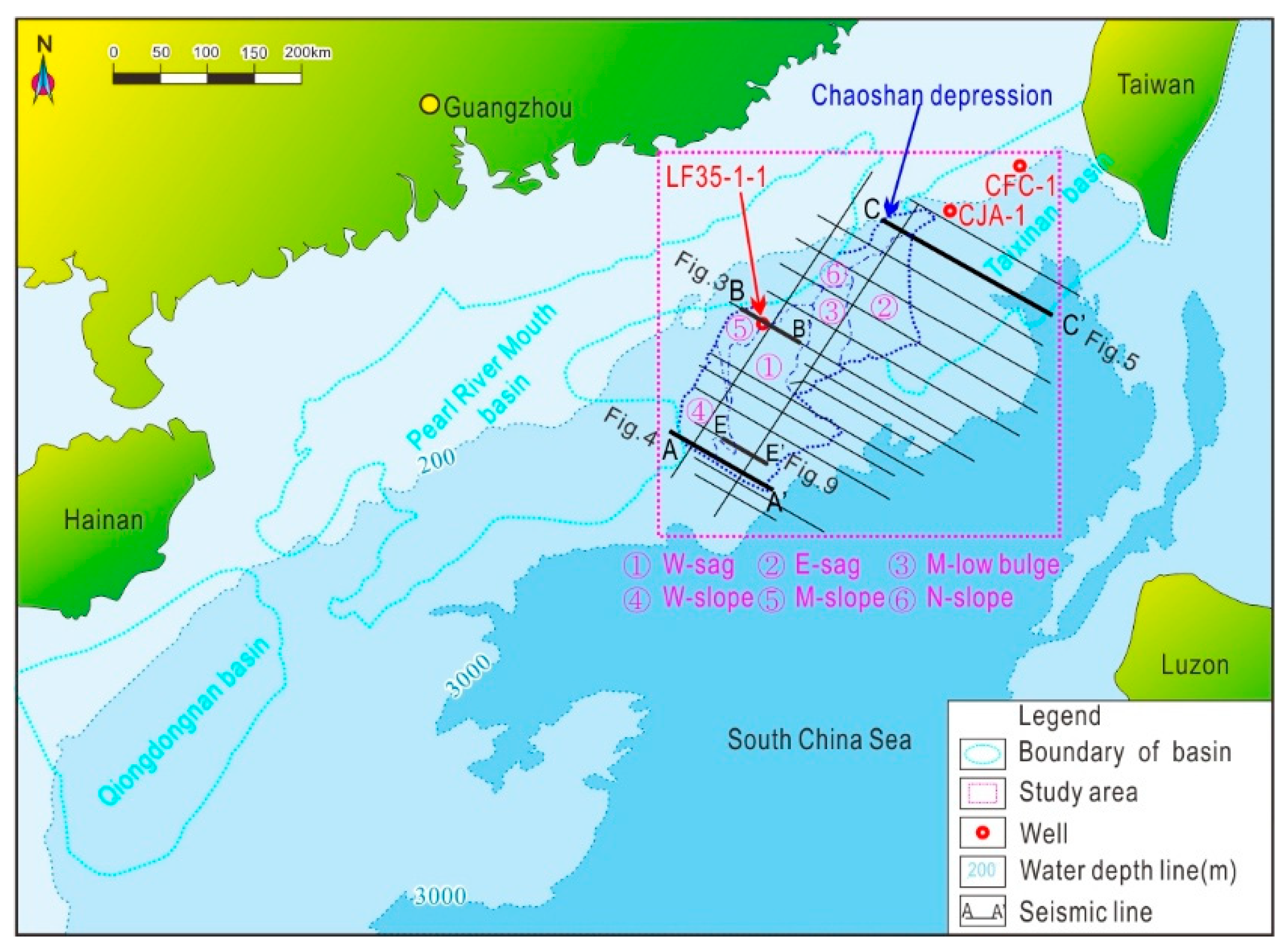
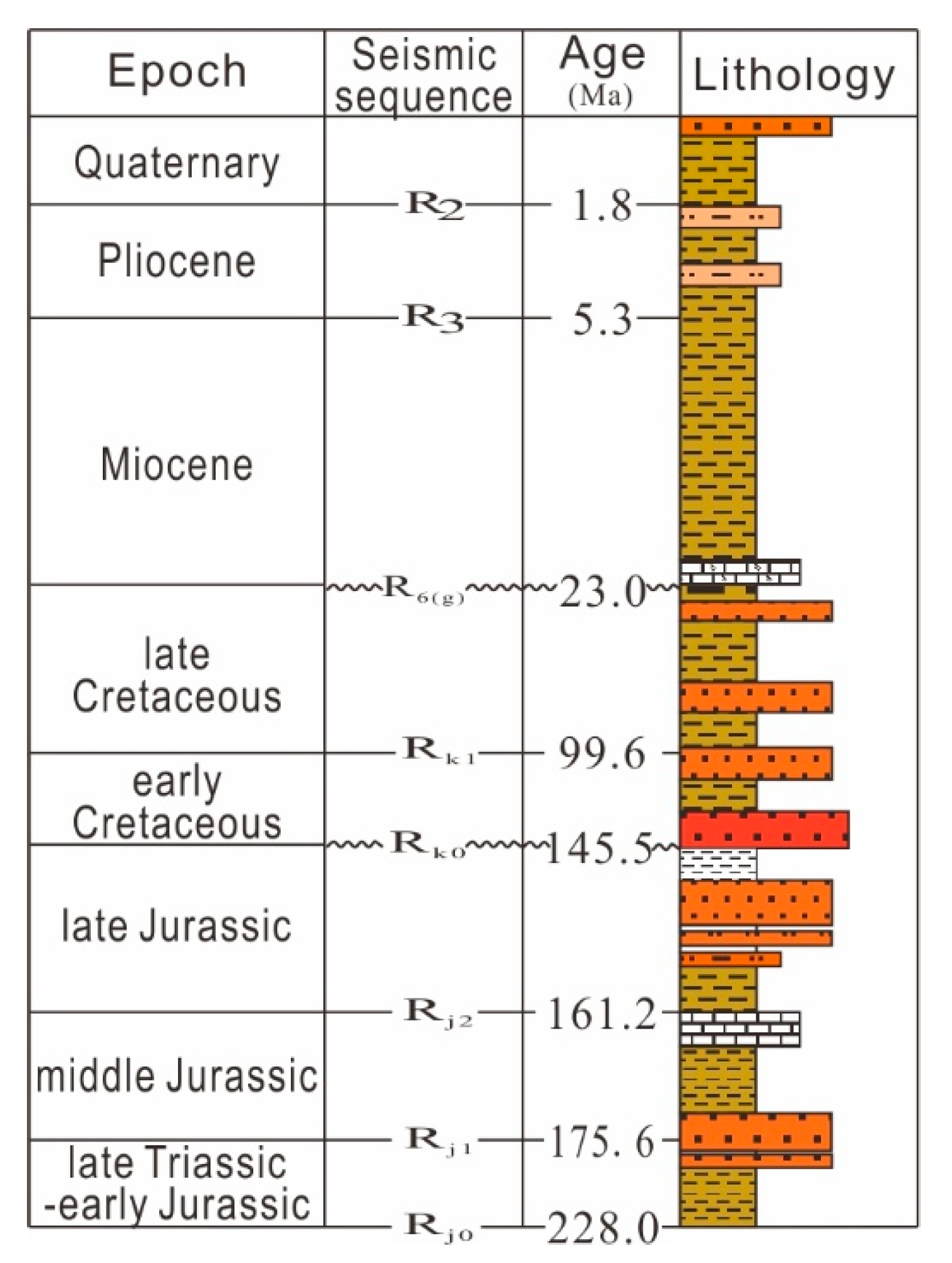

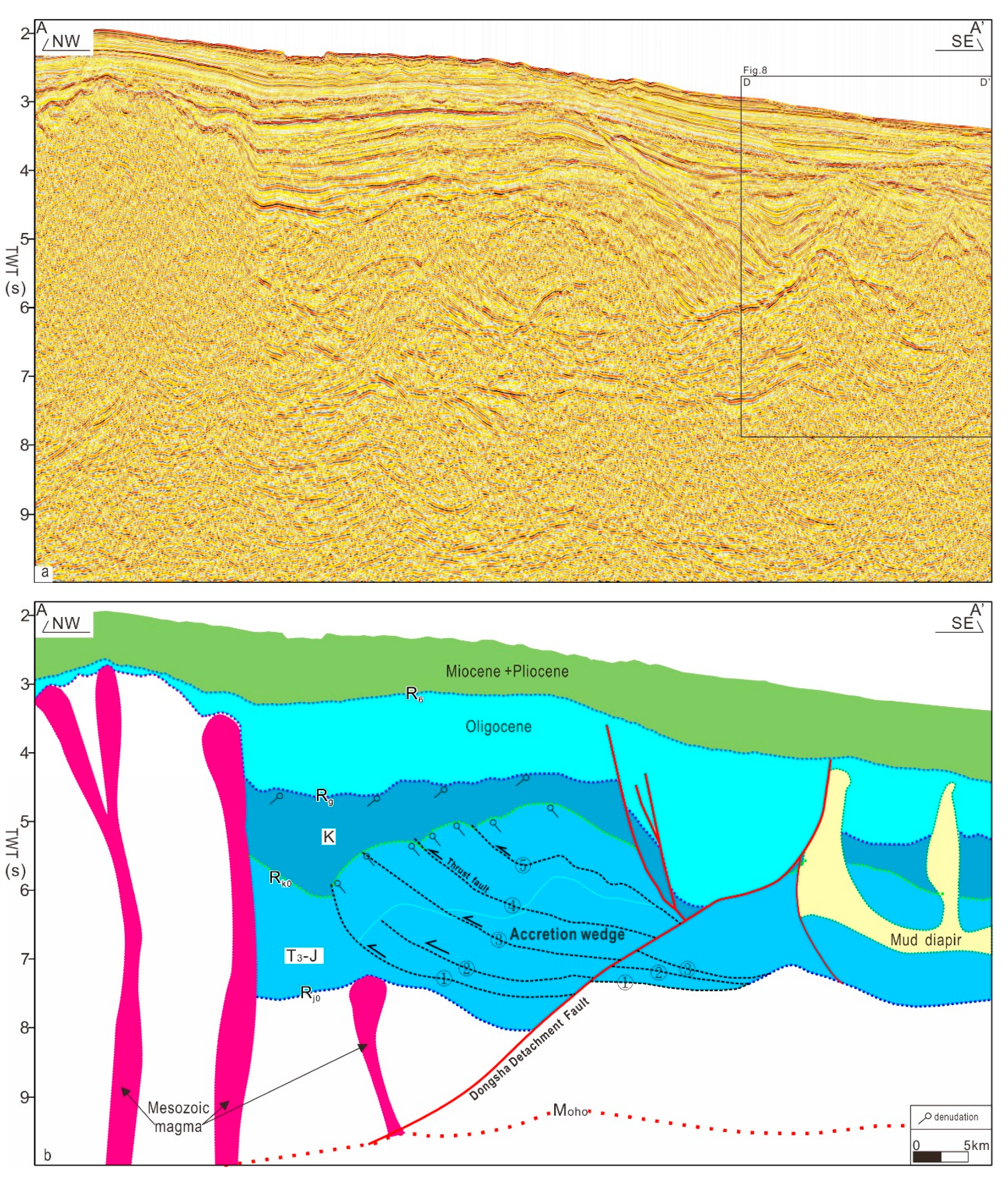
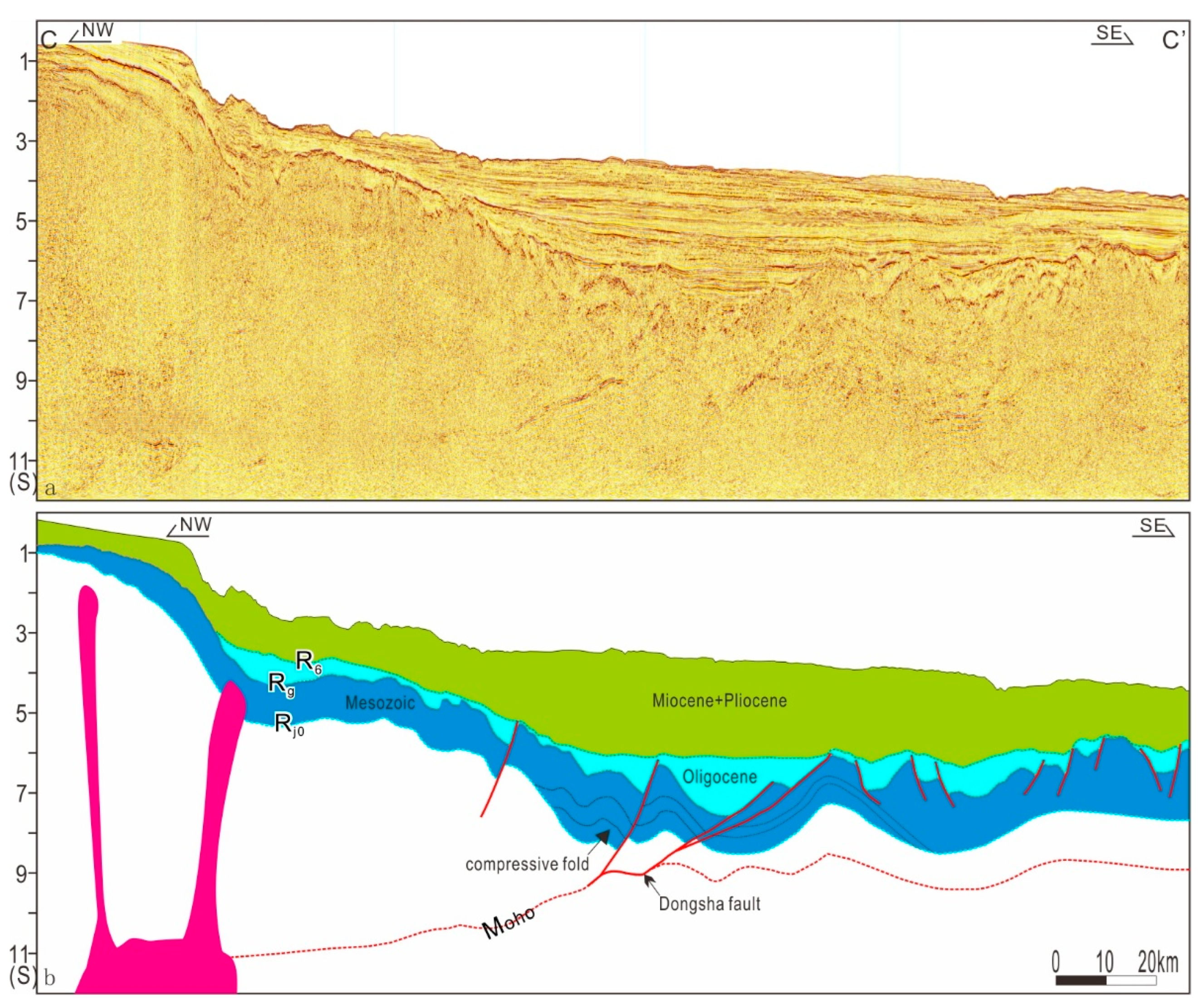
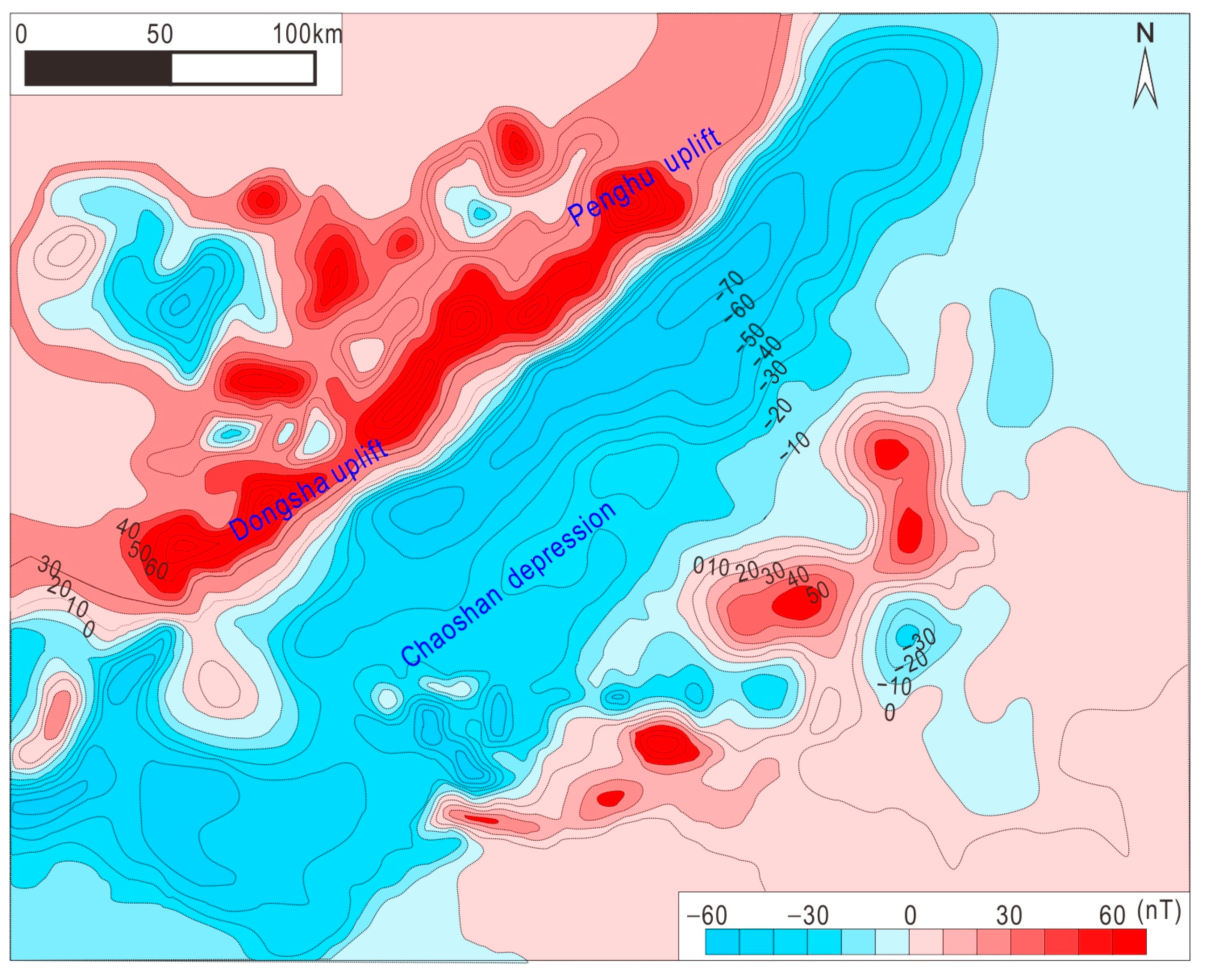

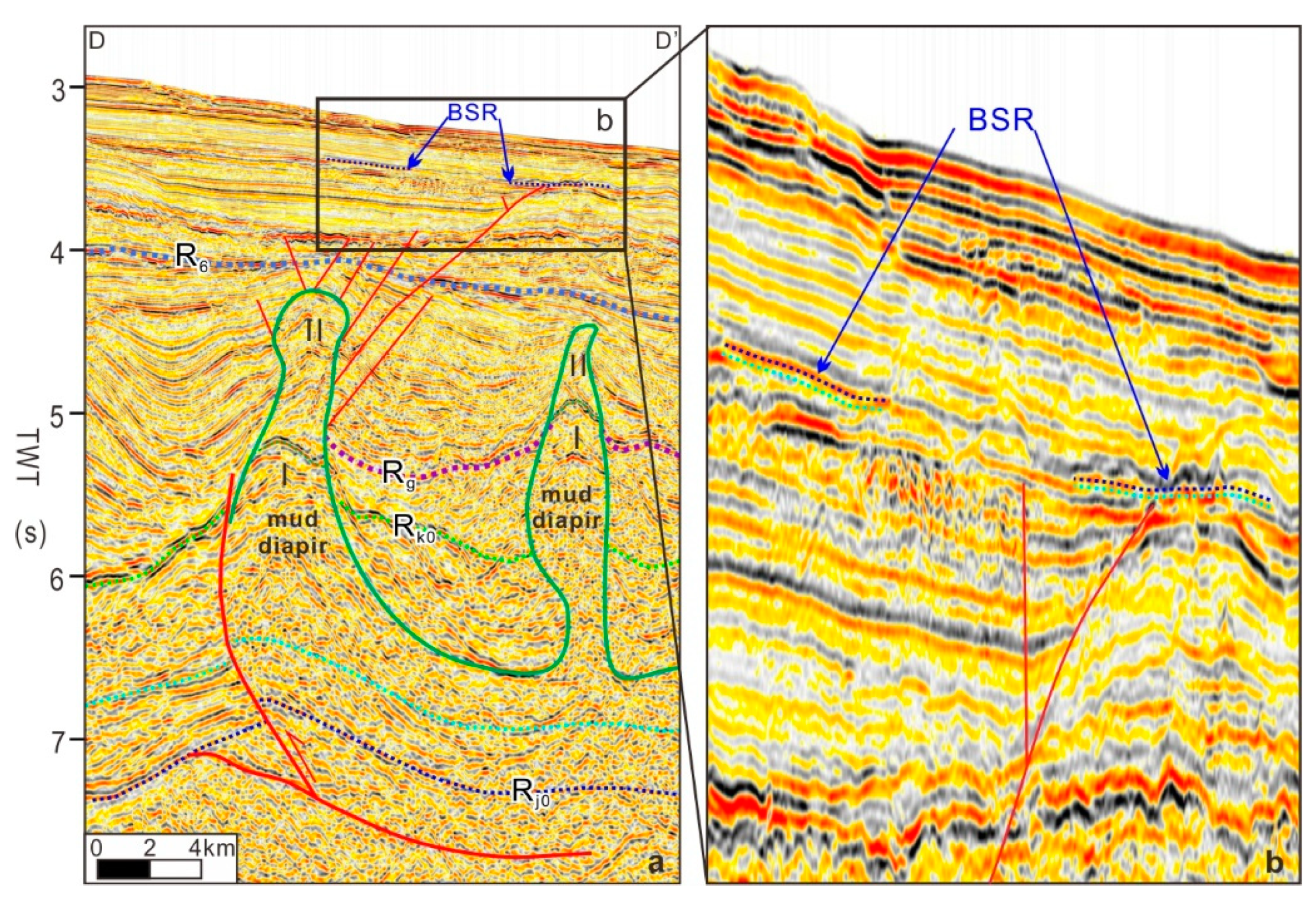
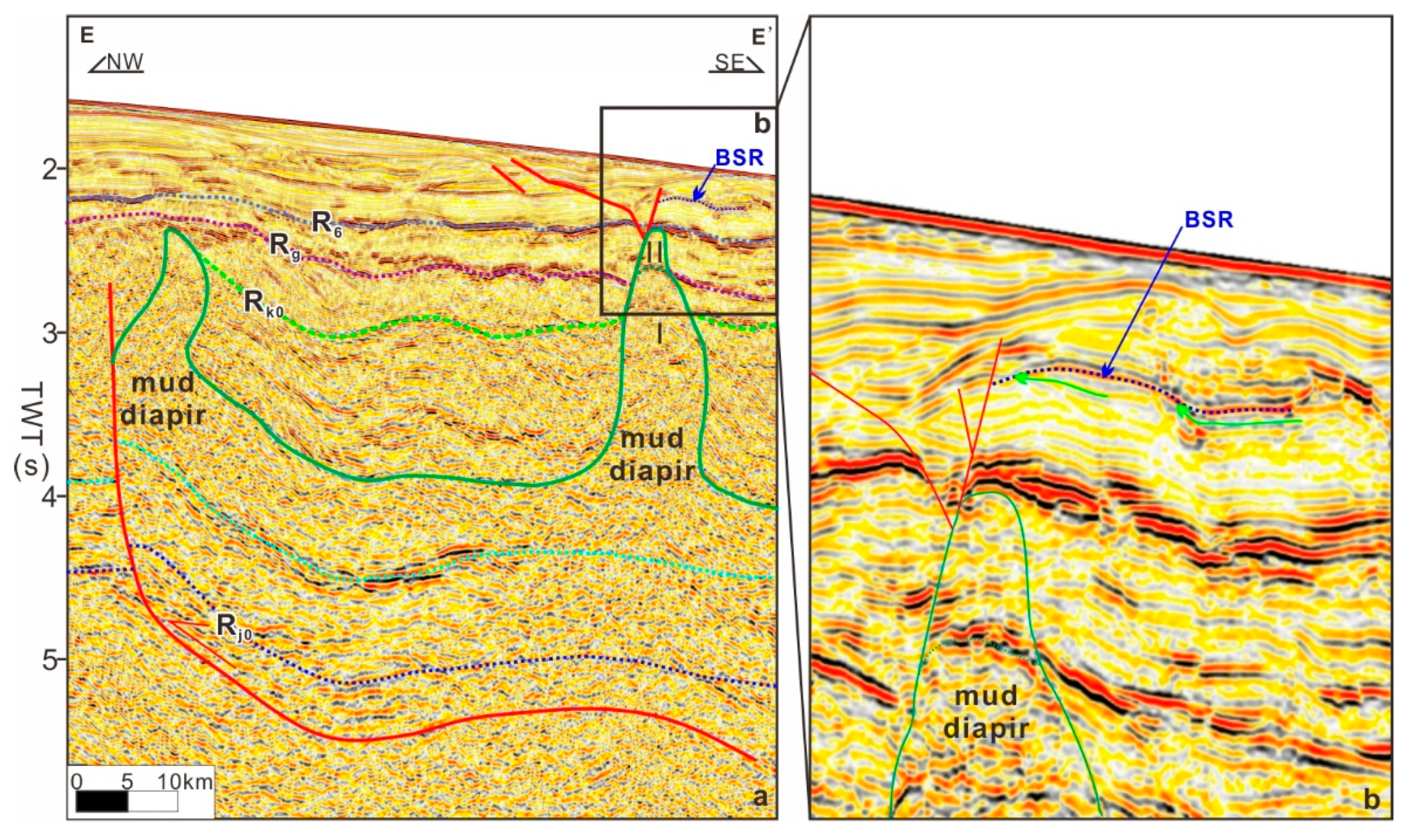
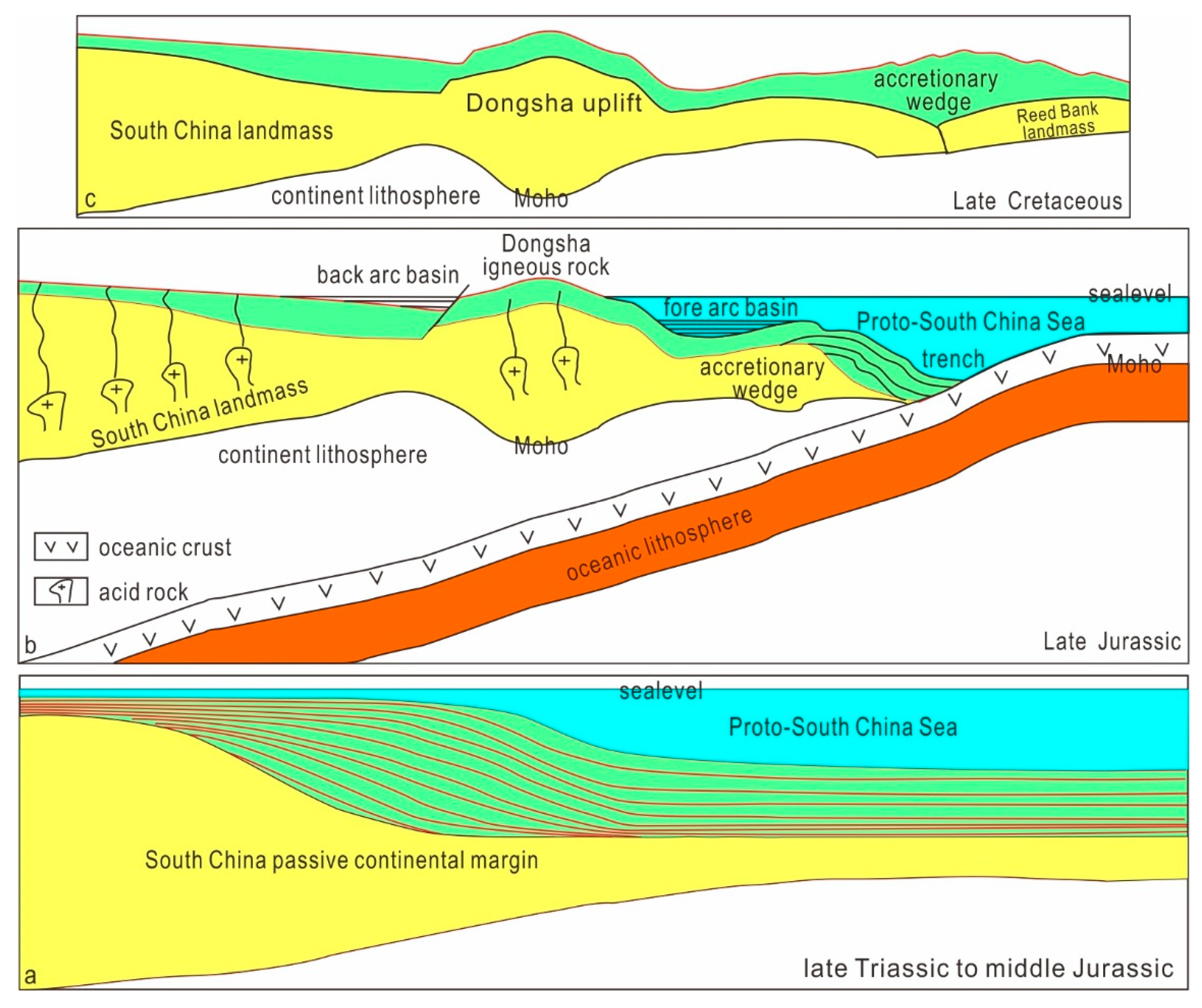
Disclaimer/Publisher’s Note: The statements, opinions and data contained in all publications are solely those of the individual author(s) and contributor(s) and not of MDPI and/or the editor(s). MDPI and/or the editor(s) disclaim responsibility for any injury to people or property resulting from any ideas, methods, instructions or products referred to in the content. |
© 2024 by the authors. Licensee MDPI, Basel, Switzerland. This article is an open access article distributed under the terms and conditions of the Creative Commons Attribution (CC BY) license (https://creativecommons.org/licenses/by/4.0/).
Share and Cite
Su, P.; Zhao, Z.; Zhang, K. The Mesozoic Subduction Zone over the Dongsha Waters of the South China Sea and Its Significance in Gas Hydrate Accumulation. J. Mar. Sci. Eng. 2024, 12, 1432. https://doi.org/10.3390/jmse12081432
Su P, Zhao Z, Zhang K. The Mesozoic Subduction Zone over the Dongsha Waters of the South China Sea and Its Significance in Gas Hydrate Accumulation. Journal of Marine Science and Engineering. 2024; 12(8):1432. https://doi.org/10.3390/jmse12081432
Chicago/Turabian StyleSu, Pibo, Zhongquan Zhao, and Kangshou Zhang. 2024. "The Mesozoic Subduction Zone over the Dongsha Waters of the South China Sea and Its Significance in Gas Hydrate Accumulation" Journal of Marine Science and Engineering 12, no. 8: 1432. https://doi.org/10.3390/jmse12081432





